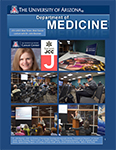
Julie Bauman, MD, MPH, chief, UA Division of Hematology/Oncology and associate director, Translational Research, UA Cancer Center, spoke Thursday evening, March 2, 2017, on "Head & Neck Cancer - The Emerging Epidemic" joined by Elizabeth Jacobs, PhD, director, Epidemiology Program, UA Mel and Enid Zuckerman College of Public Health, at the Tucson Jewish Community Center—also known as the J.
About 25 people heard them discuss various factors likely leading to an impending explosion in throat cancers, particularly among men in their 40s and 50s due to HPV 16—a form of the human papillomavirus—and how important the HPV vaccine is for everyone age 8-26 to reduce their risk.

![]() Click here [PDF] or on the image at left for a photo gallery from the lecture.
Click here [PDF] or on the image at left for a photo gallery from the lecture.
Dr. Bauman noted HPVs are an ubiquitous group of 200-plus viruses, more than 40 of which easily spread through direct sexual contact—vaginal, anal and oral. High-risk HPV 16 and 18 are responsible for most HPV-caused cancers. Low-risk HPV 6 and 11 also cause 90 percent of all genital warts. According to the National Cancer Institute, HPV 6 and 11 also cause recurrent respiratory papillomatosis, a less common disease where benign tumors grow in air passages from the nose and mouth into the lungs. About 70 percent of throat cancers are caused by HPV, with more than half in the United States caused by HPV 16, she added.
Dr. Jacobs provided a brief history of vaccines and their origins as a preventative to disease from small pox to measles, mumps and rubella (MMR) and poliovirus. Both she and Dr. Bauman debunked arguments of an anti-vaccine movement that’s emerged in recent years and noted the HPV vaccine is a safe, effective way to prevent a variety of illnesses from cervical cancer, throat cancer and genital warts.
 Drs. Bauman and Jacobs said, while both sexes can get infections due to HPV, women’s bodies are more easily able to clear infections from the virus, which also is a chief cause of cervical cancer in women (see this American Cancer Society booklet on HPV and cervical cancer). For those unvaccinated, though, there are two age cycles where they can be at higher cancer risk from HPV—for men, particularly for throat cancer, this is in their late 40s and 50s.
Drs. Bauman and Jacobs said, while both sexes can get infections due to HPV, women’s bodies are more easily able to clear infections from the virus, which also is a chief cause of cervical cancer in women (see this American Cancer Society booklet on HPV and cervical cancer). For those unvaccinated, though, there are two age cycles where they can be at higher cancer risk from HPV—for men, particularly for throat cancer, this is in their late 40s and 50s.
Dr. Jacobs mentioned recent TV ads by Merck (some running during the Feb. 5 Super Bowl) highlighting the HPV vaccine and said, if a vaccine had been available and her parents didn’t have her get it, she would have been upset. She also underscored that what’s needed today are advocates for vaccines such as HPV not opponents.
Click here for additional statistics on HPV and cancer from the U.S. Centers for Disease Control and Prevention.
Other lectures in the Bear Down, Beat Cancer lecture series will occur at the J:
- April 6, 6:30-7:30 p.m., “Diet and Cancer: What’s a Person to Eat?” – Speaker: Cyndi Thomson, PhD, RD
- May 4, 6:30-7:30 p.m., "Breast Cancer Research and Patient Care" – Speakers: Joyce Schroeder, PhD, and Pavani Chalasani, MD, MPH
ALSO SEE:
“Bear Down, Beat Cancer Lectures: ‘Head & Neck Cancer - The Emerging Epidemic’” | Posted Feb. 17, 2017
“UA Cancer Center Teams up With Tucson Jewish Community Center to Deliver Four-Part Cancer Education Series” | Posted Jan. 10, 2017
“Not to Be Outdone, DOM Leadership Keeps Academic Presses Rolling with 2016 Articles” | Posted Nov. 30, 2016
“New Chief of Hematology and Oncology at UA Health Sciences, a Noted Head and Neck Cancer Specialist, Looks Forward to ‘Homecoming’” | Posted Aug. 29, 2016

